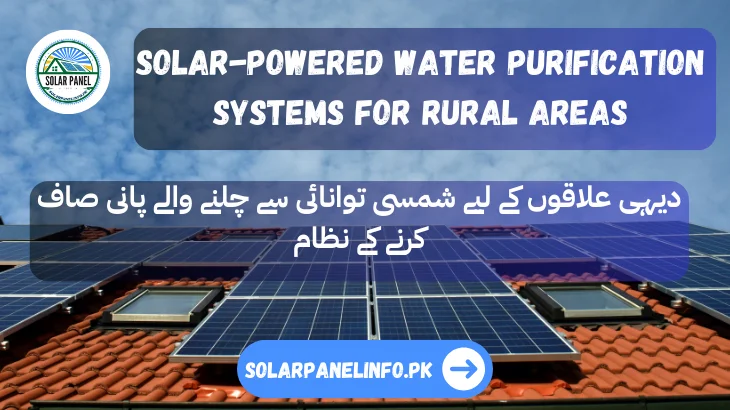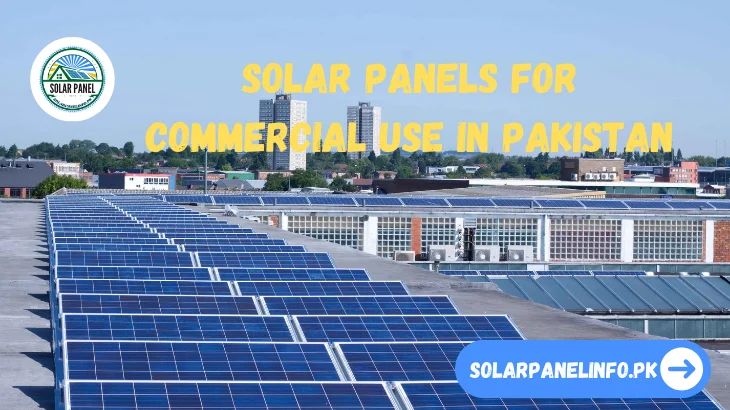Solar-Powered Water Purification Systems for Rural Areas
In several rural regions of Pakistan, access to clean and safe drinking water continues to be a major challenge. However, solar-based water purification systems are gradually changing this. The smart systems efficiently harness the sun’s rays to disinfect water suitable for drinking, cooking, and washing. Here we will discuss Solar-Powered Water Purification Systems for Rural Areas.
Read more: Solar Panels for Commercial Use in Pakistan.

پاکستان کے کئی دیہی علاقوں میں پینے کے صاف اور محفوظ پانی تک رسائی ایک بڑا چیلنج بنی ہوئی ہے۔ تاہم، شمسی توانائی پر مبنی پانی صاف کرنے کے نظام آہستہ آہستہ اس کو تبدیل کر رہے ہیں۔ سمارٹ سسٹم پینے، کھانا پکانے اور دھونے کے لیے موزوں پانی کو جراثیم سے پاک کرنے کے لیے سورج کی کرنوں کو مؤثر طریقے سے استعمال کرتے ہیں۔
The Need for Clean Water in Rural Areas
Rural areas, particularly in developing nations, often rely on water sources such as streams, ponds, or shallow wells. These water sources are often tainted with pathogens, chemicals, or heavy metals. The World Health Organization (WHO) reports that waterborne illnesses like cholera, diarrhea, and dysentery result in hundreds of thousands of fatalities annually, with the majority occurring in areas without sufficient water treatment options.
Limitations of Conventional Solutions
Conventional water purification technologies, such as reverse osmosis, UV filtration, and chlorination, typically require electricity, technical expertise, and maintenance, which may be limited in rural areas. Additionally, transporting clean water from urban centers to remote locations is often logistically and economically impractical. These challenges highlight the need for decentralized and energy-independent solutions.
How Solar-Powered Water Purification Works
Solar energy purification systems offer filtration-purification using the energy from the sun only. Some of the technologies already put into this category are:
Solar Still or Solar Distillation سولر اسٹیل یا سولر ڈسٹلیشن
This process simulates naturally occurring water cycles. Irreversibly contaminated waters are stored in a chamber to be heated under direct sunlight. When the water evaporates, salts, bacteria, and viruses remain as impurities in drinkable waters. Vaporized gases will then condense into a separate clean container.
Solar Photovoltaic (PV) Systems سولر فوٹوولٹک (PV) سسٹمز
These are the systems that comprise the solar panels and algebraically correlate them to produce electrical power, which drives mostly the common purification means, like:
- UV sterilizers
- Membrane filters, like reverse osmosis or ultrafiltration units
- Pumps for water transport and pressure
Solar Disinfection (SODIS) سولر ڈس انفیکشن (SODIS)
A low-tech solution that consists of pouring water into clear plastic bottles and exposing them to direct sunlight for 6–48 hours. The UV radiation and heat of the sun kill pathogens in the water and make it safe for drinking. Though unsuitable for highly turbid water, SODIS is an effective measure against pathogenic bacteria and viruses.
Benefits of Solar-Powered Water Purification Systems
Well-Deserved Resources of Nature فطرت کے اچھی طرح سے مستحق وسائل
Solar is free, abundant, and renewable. Hence, it is a suitable technology for far-off rural areas or off-grid applications.
Low Operating Costs کم آپریٹنگ اخراجات
Maintenance costs of solar systems are minimal, and post-installation, their fuel/electricity cost is almost negligible.
Scalable and Flexible توسیع پذیر اور لچکدار
Systems can be designed for single households, schools, clinics, or entire communities.
Environmentally Friendly
Such Solar systems provide less dependence on fossil fuels and avoid chemical contaminants, which some traditional purification means use.
Improved Health and Quality of Life
Clean water reduces the incidence of waterborne diseases, further improving school attendance and economic productivity.
Challenges and Limitations
However, the design of solar water purification systems faces some challenges, including:
- Initial Cost: Installation and equipment can be expensive, although prices have been falling.
- Weather Dependence: Performance can be affected during cloud or rain.
- Maintenance Requirements: Filters and equipment need periodic inspection and cleaning.
- Public Knowledge: Community education is necessary for the correct application and maintenance of the system.
Real-World Examples
- India: Areas including Rajasthan and Tamil Nadu have solar water-handling stations and community filtration units that provide safe drinking water for thousands.
- Africa: WaterAid and Solar Water Solutions have installed solar water systems in Kenya, Uganda, and Malawi.
- Latin America: In Peru and Bolivia, purification of brackish water is done in high-altitude villages using solar stills.
The Future of Solar Water Purification
With solar technology becoming ever more efficient and cheaper, it is expected to gain further applications in rural water treatment. Innovative methods such as solar nanofiltration, automated monitoring, and smart sensors will additionally help build reliability into the system. Collaborations among governments, NGOs, and private firms will create the necessary environment for uptake and sustainable implementation.
A Smart, Solar-Powered Solution
Solar water purification systems! Eco-friendly technologies, these systems use the sun’s energy to power the filters and purifiers that eliminate harmful bacteria, dirt, and chemicals, and provide purified water fit for drinking.
Low-Cost, Sustainable & Perfect for Communities
These solar water systems are cheap, sustainable, and easy to maintain, making for the best use in schools, clinics, and small villages. With solar technology, rural families can finally defend their right to safe and clean drinking water, free from dependence on bottled water or unsafe sources.
Conclusion
Harnessing solar energy for water purification systems presents a bright alternative to the looming issue of clean water access in rural regions, specifically in places like Pakistan. Such systems are environmentally friendly, inexpensive, and sustainable means of purifying water, which is necessary for drinking purposes, cooking, and maintaining good health. Their disadvantages, like high initial costs and dependence on weather, are far outweighed by the many advantages they bring. The below-average future of solar water purification seems to be a promising innovative solution, especially against waterborne diseases that undermine rural populations, while prospering into a brighter future with improvement in the system technology and more partnerships among the stakeholders.
پانی صاف کرنے کے نظام کے لیے شمسی توانائی کا استعمال دیہی علاقوں، خاص طور پر پاکستان جیسے مقامات پر صاف پانی تک رسائی کے بڑھتے ہوئے مسئلے کا ایک روشن متبادل پیش کرتا ہے۔ ایسے نظام ماحول دوست، سستے، اور پانی کو صاف کرنے کے پائیدار ذرائع ہیں، جو پینے کے مقاصد، کھانا پکانے اور اچھی صحت کو برقرار رکھنے کے لیے ضروری ہے۔ ان کے نقصانات، جیسے کہ اعلیٰ ابتدائی اخراجات اور موسم پر انحصار، ان کے بہت سے فوائد سے کہیں زیادہ ہیں۔ شمسی توانائی سے پانی صاف کرنے کا اوسط سے کم مستقبل ایک امید افزا اختراعی حل نظر آتا ہے، خاص طور پر پانی سے پیدا ہونے والی بیماریوں کے خلاف جو دیہی آبادیوں کو نقصان پہنچاتی ہیں، جبکہ نظام ٹیکنالوجی میں بہتری اور اسٹیک ہولڈرز کے درمیان مزید شراکت داری کے ساتھ ایک روشن مستقبل میں ترقی کرتی ہے۔
FAQ’s
How do solar-powered water purification systems work?
Solar-powered systems use solar energy to power filtration and disinfection processes, such as solar distillation, UV sterilizers, or membrane filtration, to purify water.
What are the main benefits of using solar water purification?
Solar systems are environmentally friendly, low-cost, scalable, and require minimal maintenance, making them ideal for rural areas with limited access to electricity.
Are solar-powered water systems effective in all weather conditions?
While they are efficient on sunny days, their performance can be reduced during cloudy or rainy weather, as they depend on direct sunlight.


